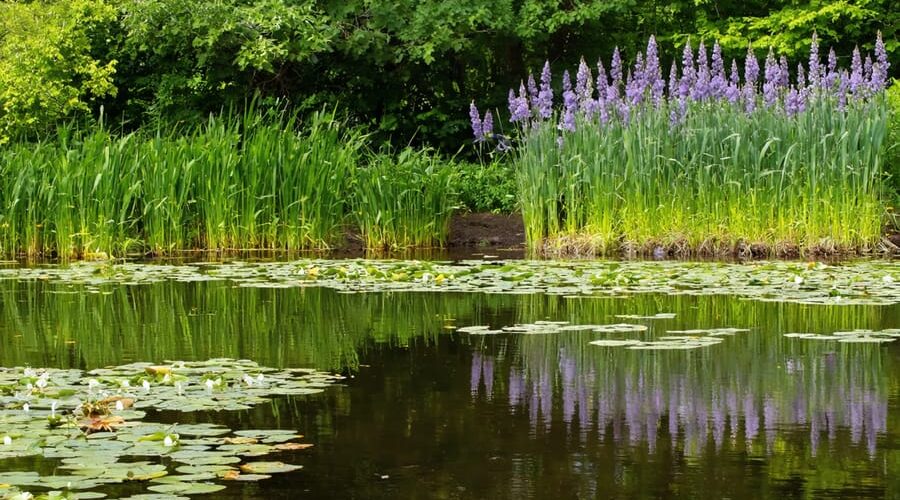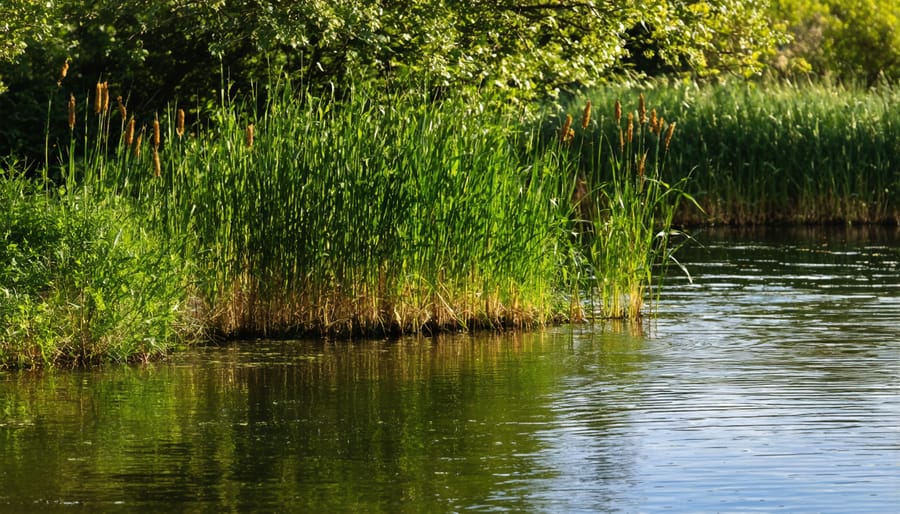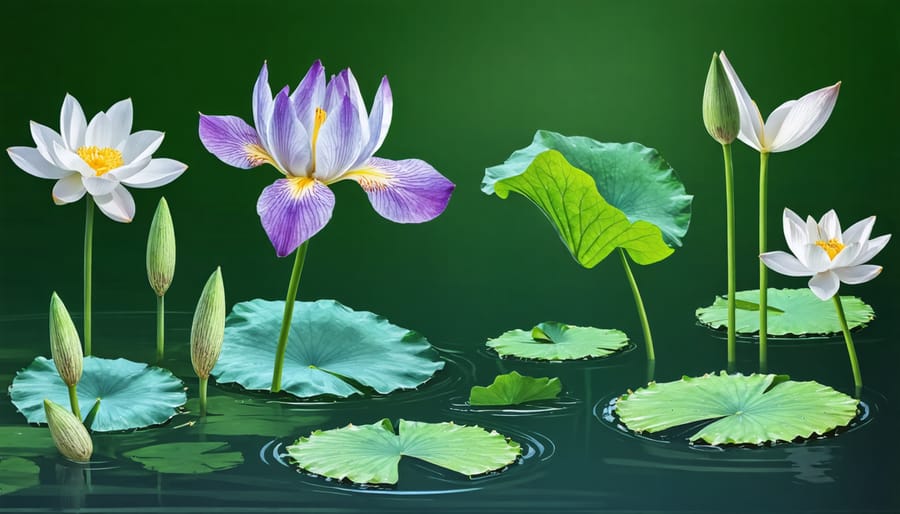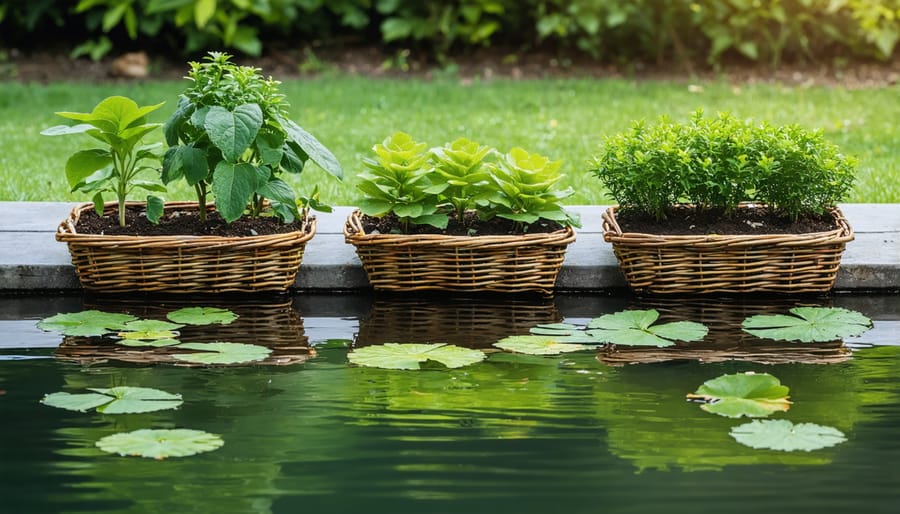
Transform Your Pond’s Edge with These Essential Emergent Plants
Transform your waterscape into a balanced pond ecosystem with emergent aquatic plants – nature’s bridge between water and land. These remarkable plants root underwater while extending their stems, leaves, and flowers above the surface, creating essential habitats for wildlife while naturally filtering pond water. From the majestic cattails swaying in summer breezes to the vibrant purple blooms of pickerelweed, emergent plants offer practical solutions for erosion control, nutrient management, and stunning visual appeal. Whether you’re establishing a new water garden or enhancing an existing pond, these adaptable plants serve as the cornerstone of healthy aquatic environments, providing crucial benefits from water oxygenation to natural bank stabilization. Perfect for both novice gardeners and experienced pond enthusiasts, emergent aquatic plants combine the best of functional water management with the natural beauty of wetland flora, creating dynamic living spaces that evolve throughout the seasons.
Why Emergent Plants Are Your Pond’s Best Friends
Natural Filtration Power
Emergent aquatic plants possess remarkable natural filtration power that helps keep pond water clean and healthy. These plants act like nature’s water purifiers, absorbing excess nutrients like nitrogen and phosphorus that could otherwise fuel unwanted algae growth. Their roots create an incredible underwater network that traps suspended particles and provides a home for beneficial bacteria.
Think of these plants as your pond’s personal cleaning crew! They work tirelessly to remove pollutants and maintain water quality. As water moves through their root systems, they filter out debris while their leaves absorb carbon dioxide and release oxygen into the water. This process not only helps clear the water but also creates a balanced ecosystem for fish and other aquatic life.
What’s really fantastic about emergent plants is how they reduce the need for chemical treatments. By competing with algae for nutrients, they naturally help prevent those pesky green blooms that can plague ponds. Plus, they provide shelter for small aquatic creatures that help keep mosquito populations in check!

Wildlife Haven Creation
Emergent aquatic plants play a vital role in creating a thriving pond ecosystem by providing essential habitat for local wildlife. These plants offer natural shelter and nesting sites for various pond inhabitants, from tiny insects to amphibians and birds. The dense stems and leaves create perfect hiding spots for small fish fry and tadpoles, protecting them from predators while they develop.
Many wildlife species rely on emergent plants for food sources too. Birds feast on the seeds and stems, while dragonflies and damselflies use the tall stalks as perches for hunting and resting. Frogs and newts lay their eggs among the underwater portions of these plants, and beneficial insects like bees and butterflies are attracted to their colorful flowers.
By incorporating a variety of emergent plants around your pond’s edge, you’ll create a natural sanctuary that supports biodiversity. Even a small collection of cattails, rushes, and iris can transform your water feature into a bustling wildlife haven that brings your garden to life with movement and sound throughout the seasons.
Top Emergent Plants for Your Pond
Easy-Care Varieties for Beginners
If you’re just starting your pond journey, these beginner-friendly emergent aquatic plants will help you build confidence without overwhelming maintenance needs. Cattails are among the most forgiving plants you can choose, naturally growing in various conditions and requiring minimal care. They provide excellent vertical interest and create natural hiding spots for pond wildlife.
Another excellent starter choice is the Arrow Arum, which adapts well to different water depths and produces attractive arrow-shaped leaves. It’s particularly hardy and can thrive even if you’re still learning optimal water conditions.
Pickerelweed is another fantastic option for beginners. Its beautiful purple flower spikes bloom throughout summer, and it’s nearly impossible to kill. This native plant requires almost no maintenance beyond occasional trimming of dead leaves.
Sweet Flag is perfect for those wanting an easy-care plant with architectural interest. Its sword-like leaves add structure to your pond’s edge, and it’s remarkably resistant to pests and diseases.
For smaller ponds, consider Water Iris. These stunning plants are not only easy to grow but also help filter pond water naturally. They bloom in spring and early summer, providing a spectacular show with minimal effort on your part.
Remember to start with just a few plants and gradually expand your collection as you become more comfortable with pond maintenance. These varieties are extremely forgiving of beginner mistakes and will help you develop your green thumb while beautifying your water garden.

Show-Stopping Flowering Options
When it comes to adding show-stopping beauty to your pond, several emergent plants offer spectacular blooms that will turn your water garden into a stunning focal point. The majestic Lotus stands out with its massive, ethereal flowers that can span up to 12 inches across, floating gracefully above large, circular leaves. Available in shades of pink, white, and yellow, these sacred flowers open each morning to greet the sun.
For dramatic vertical interest, consider Iris pseudacorus (Yellow Flag Iris) or Iris versicolor (Blue Flag Iris). These hardy plants produce striking blooms in late spring and early summer, creating a gorgeous backdrop along pond edges. Pickerelweed offers another excellent choice, displaying spikes of purple-blue flowers throughout summer while attracting butterflies and bees.
Don’t overlook the classic beauty of water lilies, which come in both hardy and tropical varieties. Their floating flowers range from pristine whites to deep crimsons, opening during daylight hours to create a magical display. For smaller water features, consider the delicate Flowering Rush, which produces pink umbrella-like flower clusters that hover just above the water’s surface.
The Cardinal Flower adds brilliant splashes of red to pond edges, while the graceful Marsh Marigold brightens early spring with clusters of cheerful yellow blooms. These show-stoppers not only create visual interest but also provide valuable shelter for pond wildlife.
Native Species Selection
Choosing native emergent aquatic plants for your pond brings multiple benefits while supporting local ecosystems. Native species are naturally adapted to your region’s climate, making them more resilient and easier to maintain. They provide essential habitat for local wildlife, including birds, butterflies, and beneficial insects, creating a vibrant ecosystem right in your backyard.
When selecting native plants, consider your local climate zone and water conditions. Common North American natives like Blue Flag Iris, Pickerelweed, and Sweet Flag thrive in most regions and offer beautiful blooms alongside practical benefits. These plants help stabilize pond edges, filter water naturally, and compete effectively with invasive species.
Start by researching plants native to your specific area through local extension offices or native plant societies. They can recommend species that will flourish in your pond while supporting regional wildlife. Consider mixing different heights and bloom times to create visual interest throughout the growing season.
Remember that native plants often establish themselves more slowly than exotic varieties, but they’ll reward your patience with long-term stability and lower maintenance needs. Start with smaller groups of plants and allow them to naturalize over time. This approach helps create a more sustainable and authentic water garden that connects seamlessly with the surrounding landscape while requiring fewer resources to maintain.
Planting and Maintenance Success Tips
Perfect Positioning
Choosing the right spot for your emergent aquatic plants can make all the difference in their growth and overall pond health. Start by considering the depth requirements of each plant species. Most emergent plants thrive in water depths between 2 to 12 inches, but some varieties have specific needs.
Create different planting zones around your pond’s edge, starting with the shallowest shelf for plants like marsh marigolds and rushes. Moving slightly deeper, position your cattails and pickerelweed in areas where the water reaches 6-8 inches. Remember to group plants with similar height requirements together to create a natural-looking arrangement.
Consider your pond’s sun exposure when positioning plants. Most emergent aquatics need full sun to partial shade, so observe your pond throughout the day to identify the sunniest spots. Place sun-loving plants like lotus and iris where they’ll receive at least 6 hours of direct sunlight.
Don’t forget about wind protection! Position taller plants like bulrushes where they can act as natural windbreaks for smaller, more delicate species. This creates a microclimate that benefits all your pond plants.
For the best visual impact, arrange plants in odd-numbered groups, and place taller varieties toward the back of viewing areas. This creates depth and allows smaller plants to remain visible. Leave some open water areas to maintain pond circulation and create a balanced ecosystem.

Planting Techniques
Installing emergent aquatic plants properly ensures their successful growth and establishment in your pond. Here’s how to plant them step by step:
First, choose the right location. Most emergent plants thrive in shallow water, typically 2-6 inches deep, where they can root in the soil while their leaves emerge above the water’s surface. Ensure the spot receives 4-6 hours of direct sunlight daily.
Start by preparing your planting container. Use a wide, shallow pot with drainage holes and fill it about two-thirds full with heavy garden soil or aquatic planting media. Avoid regular potting soil as it’s too light and will float away.
Carefully remove your plant from its nursery container and place it in the new pot. Add more soil around the roots, leaving about an inch at the top for a layer of gravel. This prevents soil from floating and keeps fish from digging.
Top the soil with a 1-inch layer of medium-sized gravel or small rocks. This helps anchor the soil and creates a more natural look. Gently water the plant to help settle the soil.
Lower the pot into your pond at the appropriate depth. For most emergent plants, the crown (where stems meet roots) should be just below or at water level. Use bricks or inverted pots as supports to achieve the right height.
If planting directly in soil around the pond’s edge, dig a hole slightly larger than the root ball. Place the plant so the crown sits at the intended water level, then backfill with soil and add gravel on top.
During the first few weeks, monitor the plants closely to ensure they’re establishing well and adjust their depth if needed.
Year-Round Care
Keeping your emergent aquatic plants healthy throughout the year requires attention to seasonal changes and specific maintenance routines. In spring, start by removing any dead foliage and dividing overcrowded plants to promote healthy growth. This is also the perfect time to add slow-release fertilizer tablets to the planting baskets, supporting robust development as the growing season begins.
Summer maintenance focuses on regular pruning of yellowing leaves and spent blooms to maintain appearance and prevent decay. Watch water levels carefully during hot spells, as proper nutrient management in ponds becomes crucial when temperatures rise. Consider adding shade plants if your emergent species show signs of leaf burn.
As autumn approaches, reduce fertilization and begin removing dying foliage before it can sink and decompose in the water. For winter preparation, cut back plants to about 2-3 inches above the water line, but don’t remove them entirely – their stems provide valuable shelter for pond life.
Common problems include yellowing leaves (often due to nutrient deficiency), algae growth around plant bases (indicating over-fertilization), and pest infestations. Address these issues promptly by adjusting fertilizer levels, maintaining proper plant spacing, and using appropriate biological controls for pests.
If plants show signs of stress, check their planting depth – most emergent species prefer their crown just below the water surface. Remember that different plants have varying care needs, so keep a simple maintenance diary to track what works best for your specific varieties.
Emergent aquatic plants are truly remarkable additions to any water garden or pond, bringing life, color, and ecological balance to your aquatic sanctuary. As we’ve explored throughout this guide, these versatile plants offer numerous benefits, from naturally filtering water and providing wildlife habitat to creating stunning visual displays that change with the seasons.
Whether you’re drawn to the majestic height of cattails, the delicate flowers of pickerelweed, or the practical benefits of arrow arum, there’s an emergent plant perfect for your water feature. Remember that success with these plants comes from understanding their basic needs: proper water depth, adequate sunlight, and appropriate soil conditions.
Starting your emergent plant journey doesn’t have to be overwhelming. Begin with just one or two hardy species, and expand your collection as you gain confidence. Pay attention to your local climate and choose plants that will thrive in your specific conditions. Regular maintenance, while important, isn’t as demanding as you might think – most emergent plants are surprisingly self-sufficient once established.
As you embark on your water gardening adventure, don’t be afraid to experiment and learn from both successes and setbacks. The rewards of growing emergent aquatic plants extend far beyond their aesthetic appeal – you’ll be creating a thriving ecosystem that benefits local wildlife while enjoying the peaceful atmosphere these plants help create.
